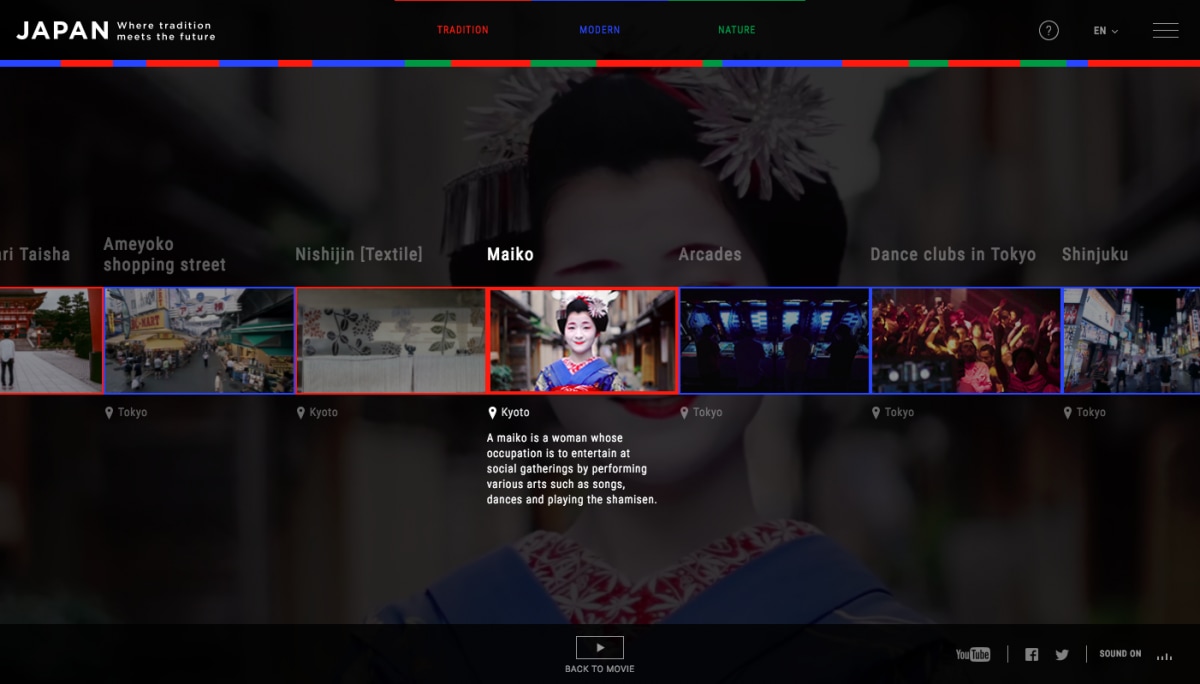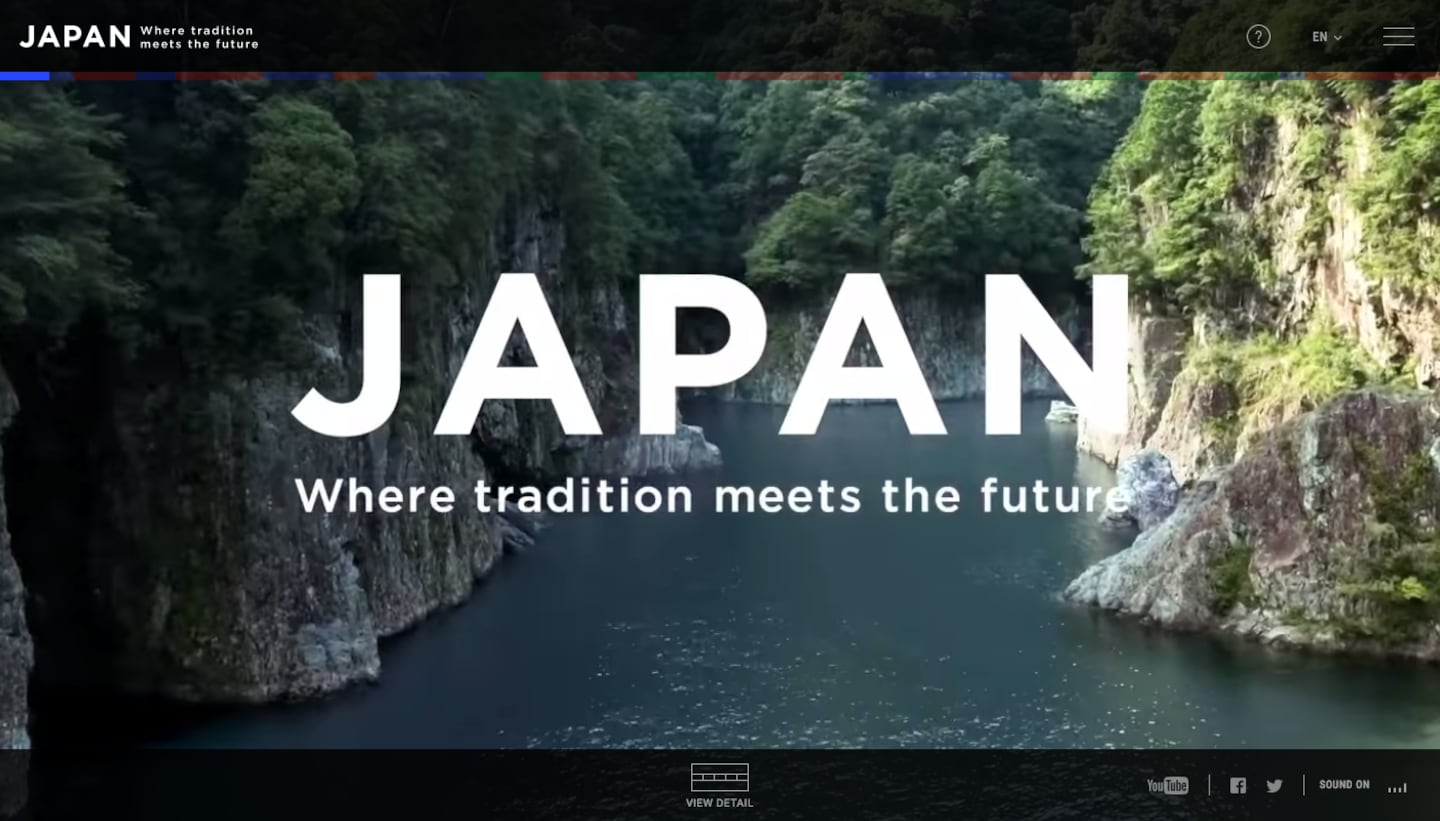Japan—Where Tradition Meets the Future
On November 7, 2016, the Japan National Tourism Organization (JNTO) launched "JAPAN—Where tradition meets the future," a campaign designed to promote inbound tourism from Europe.
By AAJ Editorial TeamThe campaign was designed by creative agency ENJIN Inc., drawing on the skills of German filmmaker Vincent Urban, whose slickly edited In Japan – 2014 racked up over 2 million views on Vimeo.
The new video aims to portray Japan's harmony between tradition, innovation and nature across 45 locations in Tokyo, Kyoto, Kumano and Ise through the eyes of an overseas traveler. It's already amassed nearly 300,000 views on All About Japan's Facebook page alone! (UPDATE: It's 1.1 million as of March 17, 2017!)

http://visitjapan-europe.jnto.go.jp/en/movie/
The JNTO Europe website offers a breakdown and description of each of the 45 different locations—just click "View Detail" at the bottom of the page. (If you have trouble figuring out how to get back to the movie afterward, just zoom out on your browser.) Information is available in English, French, German, Italian and Spanish.
The content includes major tourist spots, nightclubs, workshops and more. Since these sites are pretty stellar, we've picked out a few of our favorites to highlight below!
1. Tokyo Skytree (Tokyo)
http://visitjapan-europe.jnto.go.jp/en/movie/
Tokyo Skytree, built in 2012 amid the energetic downtown neighborhood of Oshiage, Sumida-ku, is recognized as the world's tallest free-standing broadcasting tower by Guinness World Records. Its design is modern yet traditional, with Japanese architectural styling like inward sori curves resembling those of a Japanese sword and a mukuri vault gradually bulging outward at the center like the pillars in temple architecture from the Nara and Heian Periods (8th-12th centuries).
Another one of its features is the numerous tourist facilities annexing the structure. With over 300 stores lined up in Tokyo Solamachi, you can eat and go shopping, as well as visit amusement facilities like the planetarium and aquarium.
One thing you can't miss on Tokyo Skytree are the two observatories: the Tembo observation deck at 350 meters and the Tembo galleria skywalk at 450 meters above ground. The commanding view of Tokyo is simply spectacular.
2. Morning Scripture Reading (Ninna-ji, Kyoto)
http://visitjapan-europe.jnto.go.jp/en/movie/
In Japan, the Buddhist sutra chanted before the altar (such as the Heart Sutra, Lotus Sutra or Amitabha Sutra) varies depending on the sect or temple. Lately, there are many temples where you can experience staying in the shukubo temple lodging facilities provided for monks and worshipers to participate in the morning scripture reading. For example, you can join the scripture reading at Kon-do main hall, a National Treasure of Japan in Ninna-ji, a temple in Ukyo-ku, Kyoto that is designated a UNESCO World Heritage Site. Even without comprehending all its subtle meanings, you can feel this distinctive realm of faith with your own senses in the space where the sutra chant echoes amid the glow of candles.
The scripture reading is usually performed in the early morning from 5 to 6 a.m. Although anyone can freely join, be sure to keep in mind that this is a holy religious service.
3. Fushimi Inari Taisha (Kyoto)
http://visitjapan-europe.jnto.go.jp/en/movie/
Located in Fushimi-ku, Kyoto, Fushimi Inari Taisha began as a private shrine built in the early eighth century by the Hata Clan, which came to Japan from overseas.
Although the enshrined god, Inari, was originally a god of agriculture, he also came to be worshiped as a guardian deity for business prosperity, flourishing industry and household safety. Inari is identified with the fox, which has been regarded as sacred by the Japanese since ancient times. In Fushimi Inari Taisha, foxes can be found in front of the tower gate and depicted on the ema, the small wooden plaque for writing prayers or wishes.
The main attraction of a shrine visit is definitely the Senbon Torii, which has a little less than 800 vermilion torii gates aligned on the slopes of the mountain. When light floods through the tunnel of torii, it feels like you are entering another world.
Every year in July, several thousand shrine-dedicated lanterns and stone lanterns are illuminated for the Mantoshinji Shinto lantern ritual. They dot the grounds and swathe the entire shrine area in an otherworldly atmosphere.
4. Nishijin Textiles (Kyoto)
http://visitjapan-europe.jnto.go.jp/en/movie/
Nishijin is a term for luxurious silk textiles made in the Nishijin area of Kyoto. Weaving technology was brought from China to Kyoto around the fifth century. The weaving industry took off with the court culture during the Heian Period (8th-12th centuries) after Kyoto became the capital. The Nishijin area became famous for textiles when war refugee craftsmen returned to Nishijin after the long Onin War. Its prosperity continued unabated, and when Western technologies such as the Jacquard process from France enabled significant improvements in the material, new horizons opened for development.
Nishijin production is divided into over 20 steps, each requiring highly sophisticated skills and the deep knowledge of specialized craftspeople. Its refined designs are used not only in kimono and other traditional wear (e.g. Noh costumes, uchikake, kicho and sashes), but also increasingly in other items such as neckties, interiors, drop curtains, shawls and bags.
5. Miraikan (Tokyo)
http://visitjapan-europe.jnto.go.jp/en/movie/
Miraikan – The National Museum of Emerging Science and Innovation opened in 2001 to let visitors experience various phenomena from a scientific perspective. Each floor offers scientific exhibitions, demonstrations and hands-on displays under a distinct theme.
"Discover your Earth" on the first floor has a large orb (6 meters in diameter) called Geo-Cosmos that's made of organic EL panels and floats above visitors, showing how the Earth appears from weather satellites on a daily basis. Exhibitions prepared in collaboration with artists and researchers are also held on this floor.
"Create your Future" on the third floor focuses on android and humanoid robots. A female adult android named Otonaroid and an android named Telenoid that looks only slightly human can be remotely controlled from the adjacent booth (weekdays after 3 p.m.). Honda's humanoid robot, ASIMO, also performs every day on this floor.
"Explore the Frontiers” on the fifth floor has exhibitions mainly on such themes as the universe, the global environment and the mysteries of life.
6. Nachi Falls (Wakayama)
http://visitjapan-europe.jnto.go.jp/en/movie/
Nachi Falls was chosen as one of Japan's Top 100 Waterfalls because of its height and the beauty of its single uninterrupted drop. However, this waterfall is different from others of its kind. The zone upstream on Mount Nachi is an expanse of primeval forests and divine ground for nature worship. Nachi Falls is at the mouth of this area, and the waterfall itself is the sacred object of Hiro Shrine.
People have been worshiping at this shrine since ancient times. The Kumano Kodo pilgrimage route connecting the Ise Grand Shrine with Kumano Sanzan (the three mountains of Kumano) used to pass through this location and traces of the trail can be seen near the waterfall. Around a ton of water drops from the waterfall's 133-meter height every second. Even the spray from these waters is believed to bring divine favor.
You can look up from the waterfall catchment area inside Hiro Shrine to see the power of nature. But don't miss viewing Nachi’s natural surroundings from the Kumano Nachi Taisha and Seiganto-ji Temple nearby, which are also quite outstanding.
7. Japanese Tea Ceremony (Kodai-ji, Kyoto)
http://visitjapan-europe.jnto.go.jp/en/movie/
The Japanese tea ceremony is considered an art in Japan. Sen no Rikyu, who perfected the wabi-cha style in the Azuchi-Momoyama Period (16th-17th centuries), is said to have created the foundation of the modern tea ceremony, including the use of matcha (finely ground powdered green tea) in the ceremony. Today, the three schools descended from Rikyu (Omotesenke, Urasenke and Mushanokojisenke) are still famous in the world of the tea ceremony.
The custom of drinking tea in Japan began in the Heian Period (8th-12th centuries) when the envoy to China first brought it back on his return. Semi-fermented tea resembling oolong tea was favored at the time. Introduced to Japan as a medicine, matcha became popular in the Kamakura Period (12th-14th centuries) and started being commonly consumed. In the Muromachi Period (14th-16th centuries), tea-tasting gambling called tocha, where participants guessed the origin of the tea, became fashionable. Around the same period, Juko Murata expounded on the ideal characteristics of the tea ceremony, emphasizing the spiritual relationship between the host and guest. This is said to be the origin of wabi-cha. In Kyoto, there are many places such as Kodai-ji where you can easily participate in a tea ceremony.
8. Daimonzaka (Wakayama)
http://visitjapan-europe.jnto.go.jp/en/movie/
The moss-covered stones of the Daimonzaka staired path, surrounded by cedar trees, are part of the Kumano Kodo pilgrimage route that continues for approximately 1.3 kilometers to Kumano Nachi Taisha Shrine.
The name Daimonzaka ("slope with large gate") was derived from the large gate previously standing at the top. Walking through this path, worshipers are welcomed by the remains of an old checkpoint, the entrance to sacred Furigase Bridge, and a couple of “married” cedar trees about 800 years old that tower at the foot of the stairs.
Both male and female hikers can rent pilgrim attire for a day. The thoroughly elegant traveling attire for women, called tsuboshozoku, was worn by noblewomen when going out from the Heian to Kamakura Period (8th-14th centuries) and comes with various accessories. These include a matching walking stick, zori sandals, a straw hat with hanging linen veil, a medicine cylinder hung over the neck, and a red strap hung around the chest as a talisman.
9. Hyakkengura (Wakayama)
http://visitjapan-europe.jnto.go.jp/en/movie/
The Kogumotori-goe trail in the Kumano Mountains is surrounded by a Japanese cedar forest until close to the summit where Hyakkengura, a clearing with a small enshrined Ojizo-san (stone Buddha statue), provides a breathtaking view of what people of old called "the 3,600 peaks of Kumano" extending as far as the eye can see.
This mystical site has long been considered a meeting place for the dead and the living. Imagining how people have climbed this trail for ages, you might share their sense of accomplishment upon reaching this spot. The Kogumotori-goe trail, like the Ogumotori-goe trail, stretches all the way from Hongu to Nachi, where travelers can visit three shrines: Kumano Hongu Taisha, Kumano Hayatama Taisha and Kumano Nachi Taisha.
10. Kyoyumi (Kyoto)
http://visitjapan-europe.jnto.go.jp/en/movie/
The traditional Japanese wakyu bow is around 221 centimeters long and the largest bow in the world. Wakyu is broadly classified into four types, and the kyoyumi produced since the Sengoku Period (15th-16th centuries) is still handcrafted today.
The bamboo in Kyoto, where the temperature differences are extreme, is hard to whittle and requires skill because of its highly dense, compact fiber. This material results in a bow that combines a supple pull and sharp release. The bow's production is complex, and a top-class product can take more than 10 years to make.
The core nakauchi is made first, then fitted between the uchidake inner side and todake outer side layers of the bow. This creates a repulsive force that propels the arrow far into the distance. The bow is left strung for several months to tame it, after which it is coated with lacquer and other finishes. To stabilize its shape, the bowyer himself draws the bow and shoots several thousand arrows to adjust it until it is finally completed.
To this day, the sacred treasures of the Imperial Court and Ise Grand Shrine are always kyoyumi. The photo shows bowyer Munehiro Shibata, the eldest son and successor of the Shibata Kanjuro Bow Shop, which has been handed down from generation to generation for 500 years.
11. Nagatanido (Nara)
http://visitjapan-europe.jnto.go.jp/en/movie/
Nakatanidou is famous for its yomogi-mochi, made by pounding mochi rice cakes at high speed.
Mochi is a traditional Japanese food made from mochi rice. It has long been eaten by families for good luck during the New Year holiday and other days of celebration. The practice continues to this day, and the pounding of mochi rice cakes is conducted at New Year's, seasonal festivals and other auspicious occasions.
In mochi pounding, the steamed mochi rice is put in a warmed mortar and pounded to soften it with a pestle. Synchronizing their actions, the artisans of Nakatanidou pound the mochi with lightning speed. A soft, glutinous and suitably chewy mochi is produced by quickly finishing the pounding while the mochi rice is steaming hot. It is both a performance and a tribute to their dedication to making the best-tasting mochi.
The mochi made in this manner is so soft that it keeps stretching on and on when lifted. Its melting softness in the mouth is a pleasant surprise. Watch high-speed mochi pounding here before taking a bite of the freshly made mochi.
12. Doro-kyo (Wakayama, Mie & Nara)
http://visitjapan-europe.jnto.go.jp/en/movie/
Doro-kyo is a great valley extending over 31 kilometers between sheer cliffs. Through the ages, the valley was formed by innumerable cycles of erosion, with immense waterfalls slowly carving out the catchment basin.
Traveling downstream, there are the Oku-Doro, Kami-Doro and Shimo-Doro gorges. Shimo-Doro, also known as Doro-Hatcho, is spectacularly beautiful with massive, fantastically shaped rocks and cliffs. Nature displays its artistry from season to season, with fresh greenery in the spring and crimson leaves in the fall. An airboat used to navigate the river, but now you can enjoy a cruise down the Doro-kyo valley on a large jetboat or quaint old-fashioned riverboat.
Upstream of Oku-Doro is an area where timber rafting used to be extensively practiced to transport logs felled from Kumano. The timber rafting tour there is the only one of its kind in Japan. Aside from providing plenty of thrills, the highly experienced rafters riding the rapids with one paddle are a sight to behold.
13. Gotokuji Temple (Tokyo)
This temple of the Buddhist Soto sect in Setagaya, Tokyo is said to be the birthplace of the maneki-neko (literally "beckoning cat") figurine, a lucky charm for business success.
There are many theories as to where maneki-neko came from. But one of the more credible ones is that it came from Gotokuji Temple. The beckoning paw of the standing maneki-neko cat figurine is said to invite fortune and new business opportunities. It has thus become a lucky charm for thriving business.
The story dates back to the early Edo period in 1633. When Naotaka Ii of the Hikone Clan in today's Shiga Prefecture was passing by Gotokuji Temple, he saw the Buddhist priest's cat gesturing to come in. So he stopped by and barely missed a sudden thunderstorm, attributing his good luck to the welcoming cat. Much later, a shrine was built for the cat and the maneki-neko figurine tradition began.
Since then, many believers donated maneki-neko figurines when their prayers were answered, and the collection presents a unique sight. Various sizes of maneki-neko figurines are also sold as gifts.
14. Senjojiki (Wakayama)
http://visitjapan-europe.jnto.go.jp/en/movie/
Senjojiki is located in Shirahama Nanki, one of Kansai's most scenic areas, with crystal clear waters and sandy white beaches. Its hot springs were described in the eighth century Nihon Shoki, the oldest chronicles of Japan, when the emperor visited the area.
Senjojiki's vast slabs jut into the Pacific Ocean from the tip of Setozaki to create a striking sight. Its sandstone covers about 4 hectares and was formed in the Tertiary Period (65 to 1.65 million years ago).
The name Senjojiki ("a thousand pieces laid out") suggests it would take a thousand tatami mats to cover this vast area. Made of soft, fine-grained sandstone that continues to be eroded by the waves, it is magnificently beautiful and almost belongs on the moon or another planet.
When winds rise, the waves come crashing over the unprotected area to create powerful scenes. The beautiful sunsets here tinge the bedrock with color and are famous throughout Japan.
In 2015, 1.24 million people visited Japan from Europe—with a satisfaction rate of 95 percent, and 90 percent hoping to visit again. After efforts like these, we might expect to see a few more people from Europe on the streets of Japan in the near future!




